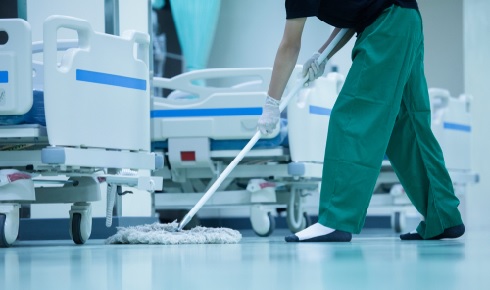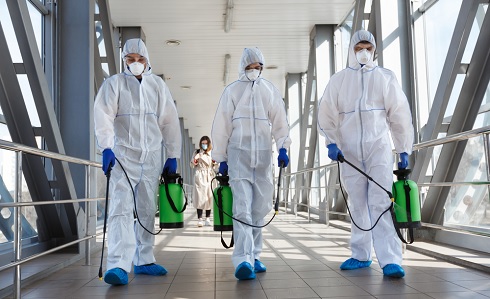A new front

Heightened sanitising during the COVID-19 pandemic is driving bacterial resistance to our most commonly used and important disinfectants, writes Samantha McCarlie
September 8th 2021
Antimicrobial resistance is one of the most pressing global threats facing humanity – potentially greater even than viral epidemics or climate change. Multi-drug-resistant bacteria are already causing hundreds of thousands of deaths a year, a figure that could rise to 10 million each year by 2050[1].
As we urgently try to develop antibiotics and methods to treat infections, these dangerous strains of bacteria are kept at bay in healthcare and other settings by the regular disinfecting of equipment, rooms and surfaces. But what if these dangerous pathogens become resistant to disinfectants too?
Our use of disinfectants and antiseptics has increased drastically during the COVID-19 pandemic and, in future, our dependence on these products is expected to rise exponentially. Disinfectants are crucial in many sectors and industries – helping prevent hospital-acquired infections in healthcare systems, destroying pathogens in the food and beverage industry, protecting livestock and, by extension, global food security. This makes it troubling that scientists have found resistance to disinfectants is also emerging at an alarming rate.
For example, Enterococcus faecium is responsible for about 10% of healthcare-associated infections globally and has well-documented antibiotic resistance capabilities[2]. In 2018 a study in two hospitals in Melbourne found isolates of E. faecium that are alcohol-tolerant and resistant to killing by 70% alcohol surface disinfection2. This followed a study in 2010 that found E. faecium isolates with alcohol tolerance tenfold higher than older isolates, essentially caused by an increase in disinfection in hospitals[2].
Within the food industry the occurrence of resistance to disinfectants known as quaternary ammonium compounds is also increasing annually. As many as 30% of Pseudomonas sp. isolated from the food and food-processing industry show some form of resistance to these disinfectants, along with 13% of Staphylococcus sp., 10% of Listeria monocytogenes, 1.5% of lactic acid bacteria and 1% of coliforms[3].
These disinfectant-resistant microorganisms have led to food-borne outbreaks, including a wave of listeriosis in South Africa in 2017–2018, which was caused by contaminated meat products and resulted in 1,060 infections and 216 deaths[4].
Resistance in the home
Disinfectant resistance is not isolated to heavily sanitised industries and medical environments – resistance to common household cleaning products is now well recorded too. The cleaning products we use in our homes every day are made up of many kinds of disinfectants and other antimicrobial compounds, but pathogenic bacteria (including L. monocytogenes) have been found with resistance to sodium hydroxide and sodium chloride, the common ingredients in washing-up liquids that we assume will kill the bacteria on our utensils.
Bacterial biofilms can be resistant to sodium hypochlorite, the active ingredient in bleach and many ‘all-purpose’ cleaners and stain removers. Streptococcus sp. have been identified exhibiting resistance to fluoride, the common antimicrobial in mouthwash and toothpaste, and an additive in drinking water. Chlorine is used globally to treat drinking water and in swimming pools, and because of widespread use, resistance to chlorine and associated compounds can be found within Pseudomonas sp., Escherichia coli, Salmonella and Enterococci to name a few.
Disinfectant resistance is a relatively novel field of study with significantly fewer publications available compared with antibiotic resistance. It is hard to quantitatively assess the scale of the problem, but the number of publications on disinfectant resistance is increasing year on year.
 Bacteria in hospitals have been found with resistance to 70% alcohol, the optimal concentration for disinfectants and hand sanitiser
Bacteria in hospitals have been found with resistance to 70% alcohol, the optimal concentration for disinfectants and hand sanitiser
How resistance develops
In general, resistance to disinfectants develops in a similar way to antibiotics, emerging slowly after many years of exposure, with isolated outbreaks once a particularly resistant strain evolves. Surveillance of antimicrobial resistance over the past few decades has shown that the number of disinfectant-resistant isolates and nosocomial (hospital-acquired) infections is increasing, and outbreaks of disinfectant-resistant bacteria are becoming more frequent. In addition, overall levels of susceptibility to disinfectants are decreasing in areas where they are used frequently.
The exposure of any microbial population to any antimicrobial will create selective pressure that can drive the emergence of resistance, but overuse and improper dosage can accelerate that emergence. Disinfectants have multiple cellular targets and as a result, for resistance to evolve, microorganisms must have several resistance mechanisms working simultaneously. The most common mechanism of disinfectant resistance is via efflux pumps – proteins found on the bacterial cell membrane that literally pump antimicrobials out of the cell, lowering the concentration inside the cell and limiting intracellular damage.
The formation of tough biofilms is also common among pathogenic bacteria as a means of defence against disinfectants. Bacteria can also modify the chemicals in disinfectants and in rare cases metabolise them[5]. Many of these defensive mechanisms can be traced back to specific genes harboured on mobile genetic elements[5]. These genes confer resistance to their host cell and are easily transferred within a bacterial population and between species.
Some mechanisms, such as multi-drug efflux pumps, can lead to cross-resistance to several types of disinfectants and antibiotics, and some resistance mechanisms can help bacteria develop resistance to both disinfectants and antibiotics.
For example, a study in 2018 found that the evolution of resistance to the disinfectant benzalkonium chloride promoted the simultaneous development of antibiotic resistance[6]. This occurred in an isolate of the opportunistic pathogen Pseudomonas aeruginosa that was exposed long-term to benzalkonium chloride, but had no exposure to any of the antibiotics to which it later became resistant[6]. This suggests that when bacteria are under stress, antibiotic and disinfectant resistance genes can be co-selected to create isolates resistant to both disinfectants and antibiotics.
The fight of the future
Recent advances in sequencing technology and gene editing will shape the way we study and fight back against antimicrobial resistance. Through this technology, scientists can track the epidemiology of antimicrobial resistance. Likewise, surveillance of rapidly emerging disinfectant resistance is crucial to study the spread of multi-drug-resistant isolates and gene transfer between populations.
If specific outbreaks, industries and regions can be targeted and monitored, it could help inform more intelligent and targeted day-to-day disinfection procedures. A better understanding of the mechanisms of disinfectant resistance may help hinder the emergence and spread of decreased susceptibility and even reverse resistance altogether. For example, efflux pump inhibitors have been designed and used in various studies to increase bacterial susceptibility to biocides[7].
Furthermore, studies have shown that CRISPR-Cas technology can be used to resensitise resistant bacteria to antibiotics [8,9]. This has been performed successfully on both extended-spectrum beta-lactamase-producing E. coli[8] and methicillin-resistant Staphylococcus aureus (MRSA)[9], where antibiotic resistance genes within these bacteria were targeted and disrupted.
Although we still have a way to go, advances in sequencing and gene editing technology will be indispensable tools in the fight against antimicrobial resistance both for antibiotics and disinfectants.
As mentioned, these multi-drug-resistant isolates evolve at a faster rate when antimicrobials are used improperly or are of poor quality. However, it is important to note that even when antimicrobials are used properly at the correct dosage, selective pressure is still created. Most resistant strains are isolated from medical environments and the agricultural industry where antimicrobials will always need to be used extensively.
 From public transport to school classrooms, the use of disinfectants has risen dramatically during the COVID-19 pandemic
From public transport to school classrooms, the use of disinfectants has risen dramatically during the COVID-19 pandemicSecond, if you are using a non-alcohol-based sanitiser, or household cleaning products, make sure you do not dilute the product below the recommended level. Mixing a range of cleaning products with different active ingredients can ensure you have the best coverage against different resistance mechanisms (although bleach and other very strong cleaners such as sink-unblockers should not be mixed with other substances). If we use disinfectants and other antimicrobials responsibly, the emergence of resistance can be controlled in time for new formulations to be produced and for further research.
In 2015 the World Health Organization released the ‘Global action plan on antimicrobial resistance’ with the aim of ensuring responsible use of medications (and other antimicrobials) for successful treatment and prevention of infectious diseases. The issue of disinfectant resistance is starting to be recognised on a global scale and it is not too late to turn the tide to prevent another large-scale resistance crisis, which will no doubt have very serious implications for humankind.
Samantha McCarlie is a master’s student at the University of the Free State, South Africa, following a degree in microbiology. To date she has published three scientific papers on disinfectant resistance and works as a scientific consultant in the chemical industry.
1) World Health Organization. Healthcare-associated infections fact sheet. World Health Organization (2015).
2) Pidot, S. J. et al. Increasing tolerance of hospital Enterococcus faecium to handwash alcohols. Sci. Trans. Med. 10(452) (2018).
3) Langsrud, S. et al. Bacterial disinfectant resistance – a challenge for the food industry. Int. Biodeter. Biodegr. 51(4), 283–290 (2003).
4) Situation Report (PDF). Department of Health, Republic of South Africa. 26 July 2018. Retrieved 21 May 2019.
5) McDonnell, G. & Russell, A. D. Antiseptics and disinfectants: activity, action, and resistance. Clin. Microbiol. Rev. 12(1), 147–179 (1999).
6) Kim, M. et al. Widely used benzalkonium chloride disinfectants can promote antibiotic resistance. App. Environ. Microbiol. 84(17) (2018).
7) Baugh, S. et al. Inhibition of multidrug efflux as a strategy to prevent biofilm formation. J. Antimicrob. Chemother. 69(3), 673–681 (2014).
8) Kim, J. S. et al. CRISPR/Cas9-mediated re-sensitization of antibiotic-resistant Escherichia coli harboring extended-spectrum ß-lactamases. J. Microbiol. Biotechnol. 26(2), 394–401 (2016).
9) Bikard, D. et al. Exploiting CRISPR-Cas nucleases to produce sequence-specific antimicrobials. Nat. Biotechnol. 32(11), 1146–1150 (2014).


